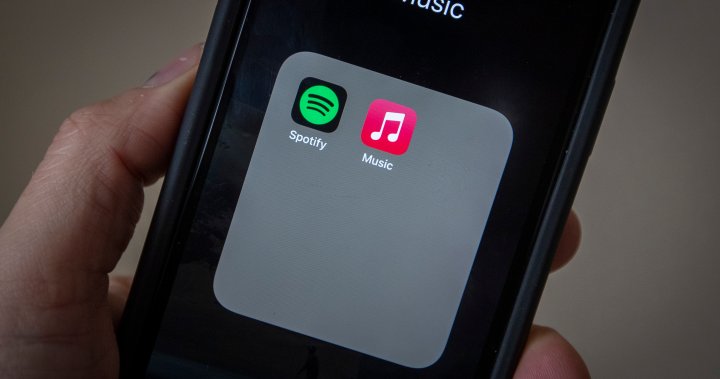Which Music Streaming Service Is Right For You? It Might Depend On Your Personal Ethics – National

A new investigation Earlier this month, research revealed that streaming accounts for 84% of recorded music consumption revenue in the United States. I suspect that number is slightly lower in Canada, but we continue to embrace this technology more and more each month. Streaming is not only the future, but the present.
When choosing a music streaming service, the options aren’t limited to the big four: Spotify, Apple Music, Amazon Prime Music, and YouTube Music. There’s a second tier of platforms that includes Deezer, Qobuz, Tidal, SoundCloud, and Napster (the legal service officially known as Rhapsody). Going further, there’s 8Tracks, Tunein, AccuRadio, iHeartRadio, Boomplay, Jango, and maybe a dozen others.
There is another segment that specializes in specific ethnicities and genres. JioSaavn and Gaana, for example, focus on Indian content, Patari caters to the Pakistani market, Moov is dedicated to Southeast Asian music, and Anghami is for the Arab world. IDAGIO is designed for classical music fans, while ROXi is for those who love karaoke. All draw on the same massive catalog of over 120 million digital tracks.
In the West, most music fans stick with the Big Four. Spotify is the largest software company, with more than 600 million average monthly users (AMUs), about 246 million of whom pay a subscription fee that unlocks the full functionality of the app and user interface. (That’s slightly less than QQ Music, a joint venture between Spotify and Tencent, but that streaming service is primarily aimed at the global Chinese market.) Apple Music, Amazon Music, and the fast-growing YouTube Music each have about 100 million AMUs.
Among all these choices, which one is best for you? It depends. What sets these platforms apart? Let’s take a closer look.
The first question you need to ask yourself is, “Do I want to pay to listen to music?” If the answer is no, then you’re limited to “freemium” offerings from Spotify, iHeartRadio, and a limited library on Amazon. It doesn’t cost anything to listen, but you have to sit through ads multiple times an hour, and the app and desktop features are limited. Some artists are also known for not offering their music on free plans. Want all the features? Then you have to pay.
Some streaming services are available worldwide, while others can’t travel outside of specific geographic territories due to the terms of their music licenses. If audio quality is important to you, Amazon, Tidal, Qobuz, and Deezer are among the companies that offer high-resolution streams, meaning music is delivered in CD quality or better. Apple offers Spatial Audio, which to my ears sounds pretty good. Spotify lags behind in this area, although it continues to promise to launch Spotify HiFi any day now.
What differentiates streamers from each other? The look and feel of the app/desktop version. Some offer better lyrics and metadata than others. Search experiences can be wildly different. And, of course, there are the proprietary recommendation algorithms, each powered by their own arcane secrets. Let’s start there.

Get the latest national news
For news that impacts Canada and the world, sign up to receive breaking news alerts directly when it happens.
Spotify has been annoying me lately because it seems to be pumping songs into my feed that I don’t want and don’t care to hear. As a rocker, why am I being fed songs that I don’t want to hear? Please, s… by Sabrina Carpenter? I’ve never intentionally named a Kendrick Lamar song, so why does Spotify sometimes push me in his direction? Some conspiracy theorists believe Spotify’s algorithm can be changed from “recommendation” to “promotion.” And if it is indeed a promotion, that means someone is paying for it. Who? Is this the new bribe?
Another factor might be your personal code of ethics regarding compensating artists for their music. It’s… complicated.
Every few years, every streamer has to negotiate licenses with rights holders, a process that involves record labels, publishers, copyright boards, distributors, aggregators, and collecting societies. Rights holders, who are supposed to have the musician’s best interests at heart, want to get the most out of streamers. Streamers, meanwhile, want to keep costs down. When rights holders take their cut, whatever’s leftover is passed on to the artist. These royalty payments also vary depending on the artist’s contract with their label and publisher.
So how much are these payments? Google searches yield all sorts of figures.
The average Spotify payout per stream is generally thought to be $0.003 to $0.005. Apple Music is said to pay between $0.007 and $0.01 per stream, with a promise pay up to 10 percent more to artists those who download music in Apple’s Spatial Audio format. Most others fall somewhere in between, with the exception of Tidal ($0.012 to $0.015 per stream) at the high end and YouTube Music at the very low end (a nanoscopic $0.00069 per stream).
But it gets more complicated. You have to look at the methods used to split subscription revenue and ad revenue at the end of each month.
Spotify uses a system called “Streamshare.” About two-thirds of every dollar Spotify collects goes to royalties. If you pay an average of $10 a month, three of those dollars go to Spotify and the other seven go to royalties. All of that money goes into a pool. Spotify then looks at how many times music owned or controlled by the various rights holders was streamed in a month. The company then divides the amount of money in the pool by the number of streams viewed by the rights holders in each market. If, for example, Universal Music owns the rights to 42% of all songs streamed in a given territory in a given month, it gets 42% of the royalties.
In other words, if you think your subscription money is going to the indie artist you’ve been listening to on repeat for 30 days, think again. Most of that money is probably going to a major label. And if your favorite artist gets streamed less than 1,000 times a month, they get nothing. That’s Spotify’s policy. That’s why some platforms, including Tidal and SoundCloud, are working toward a user-centric model where if you stream an artist’s song, your money goes to the artist.
There’s also the issue of Spotify’s “bundling.” Because of the way Spotify is licensed, revenue and costs increase in tandem. The more money Spotify makes, the more it has to pay. If the company focused solely on providing music, it would lose money every year for the rest of the universe. So Spotify has been looking for ways to control costs and slow down payments while keeping users engaged on the platform. That’s why Spotify got into podcasting, which is a way to engage audiences at no cost to them. It’s also why there’s “bundling,” which is the bundling of other options into a music streaming subscription. This has recently included audiobooks.
In the US, Spotify’s audiobook bundle allows it to pay musicians a discounted rate because they also pay royalties to authors. Yes, authors deserve to be paid, but including audiobooks in the calculation (see the explanation above on stream sharing) means that the percentage of collected revenue that goes to musicians will decreaseperhaps $150 million over the next year. Book publishers are also concerned that it will affect payments to their authors. And by the way, Spotify doesn’t pay anything for an audiobook unless someone listens to at least 10% of it.
So, which streaming platform is best? As the title says, it all depends on your personal ethics. If you want artists to be paid the maximum amount, Tidal and Apple Music seem to be the way to go. For audiobooks, a service like Audible or similar seems to be the way to go.
But you’ll need to sign up for a subscription. Given that each platform will give you instant access to nearly the entire musical catalog of humanity for the price of a single CD (and Audible has thousands upon thousands of books available for less than the price of a single paperback), this seems like a good deal to me.
Better yet, you can go to a record store or bookstore. Physical copies of artwork will always be better for the artist than digital copies.





















